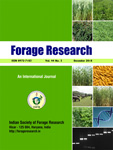GULAB PANDOVE*, NIRMAL SINGH, NEERAJ RANI AND SOHAN SINGH WALIA
School of Organic Farming, Punjab Agricultural University, Ludhiana-141 004 (Punjab), India
Department of Microbiology, Punjab Agricultural University, Ludhiana-141 004 (Punjab), India
*(e-mail: gpandove@pau.edu)
(Received : 4 March 2025; Accepted 28 March 2025)
SUMMARY
Vermicompost is one of the most popular organic fertilizers that is produced by the activity
of Earthworms. Vermicompost is a nutrient-rich (Macronutrients) and microbiota enriched product,
making it an excellent soil amendment. It enhances soil fertility, promotes crop productivity and
supports sustainable agricultural practices. It also helps to enhances soil structure via soil aeration,
water retention and root penetration. Vermicomposting occurs in the presence of oxygen. This
reduces odour and pathogen. Earthworms ingest organic matter, break it down and excrete a nutrient-
rich. microbe-dense vermicompost. The entire process of vermicomposting involves a complex inter
play of earthworms, microorganisms and decomposing organic matter. The microbial communities
within earthworm gut and cast are found to be highly efficient and capable of digesting wide range
of organic material and polysaccharides (cellulose, sugars, chitin, lignin, starch). In addition of
macro and micronutrients, the vermicompost found to be rich in phosphate solubilizers, nitrogen-
fixer fixing bacteria, enzyme producers and plant growth promoting bacteria. Likewise, enzymes like
urease, -glucosidase, phosphatase have been reported in vermicompost. Thus, the present review
will feature, various methodology for the preparation of vermicompost, microbiome of vermicompast,
physical properties of vermicompost, impact of vermicompost on plant health, antifungal features
impact of vermicompost on soil health, its role in disease resistance, application methods enzymatic
profiling, conventional compost vs Vermicompost and its application in forage, crops. The realization
attained from the literature assessed herein will further help to understand the role of vermicompost
in forage crop.
Key words: Disease resistance, Earthworms, Enzymes (Urease, -glucosidase, Phosphatase), Soil fertility, Microorganisms, Vermicompost

